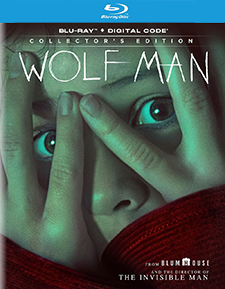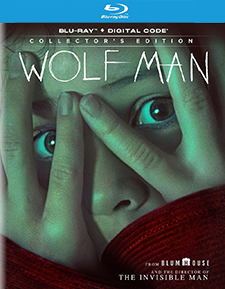Wolf Man (Blu-ray Review)

Director
Leigh WhannellRelease Date(s)
2025 (March 18, 2025)Studio(s)
Blumhouse Productions/Cloak & Co. (Universal Pictures Home Entertainment)- Film/Program Grade: C
- Video Grade: B+
- Audio Grade: A
- Extras Grade: B+
Review
Werewolves play a significant role in cinematic horror history, with Werewolf of London, The Wolf Man, The Curse of the Werewolf, I Was a Teenage Werewolf, and An American Werewolf in London among the best-known. Wolf Man, a recent entry in this subgenre, tweaks the formula somewhat to create a variation on the legendary monster for modern audiences.
A prologue set in 1995 shows a father and son heading out on a deer hunt. The father is stern with the boy but also protective. In an eerie, harrowing scene, they’re stalked by something and hide in a deer blind. From their crouched point of view, we hear the sounds of an approaching creature and even see its breath beyond the wall of the blind. But miraculously, whatever was stalking them disappears.
Now, thirty years later, the boy has a family of his own. His name is Blake Lovell (Christopher Abbott, Poor Things). He’s a writer who lives in San Francisco with his wife, Charlotte (Julia Garner, The Royal Hotel), and their daughter, Ginger (Matilda Firth, Disenchanted). Notified that his farther has been officially declared dead, Blake and his family visit his childhood home in Oregon primarily to clear out his father’s possessions. As Blake drives the family to his father’s cabin deep in the woods, he sees someone or something standing in the middle of the narrow dirt road, swerves to avoid it, and crashes. The family emerges unhurt only to find themselves pursued by a beast. They reach the cabin, barricade themselves in, and spend a frightening night trying to survive. Blake gets injured in one of the creature’s attacks and gradually begins to transform physically and mentally.
Director Leigh Whannell, co-creator of the Saw franchise, takes his time showing Blake’s deterioration into a werewolf. Initially, he looks like he has a fever or is coming down with flu. Later, he breaks into sweats, speaks incoherently, and loses teeth. During these stages, he remains mostly himself. Charlotte and Ginger worry about him but can’t call for help because there’s no phone reception in their rural part of Oregon. As time passes, the human aspect of Blake gives way to the animal and his physical appearance changes dramatically. The original creature continues to attack, Blake’s protective instinct kicks in, and the two man/beasts engage in a brutal, snarling struggle.
The make-up effects are quite good and avoid the customary hairy-animal design typical of werewolf pictures. Instead, Blake’s infection is treated as a consistently worsening disease. Old tropes such as transforming into a werewolf by the full moon and being destroyed by a silver bullet are jettisoned in favor of something less fantastical, and more relatable. What does remain is the cause of becoming a werewolf—being bitten by another werewolf.
Abbott is not a terribly sympathetic actor and I found myself not really caring about his plight. Even though early scenes show his Blake joking with his daughter Matilda, he fails to convey warmth. This hurts the film and diminishes the contrast between Blake’s human self and his animal self. Abbott does better at portraying the stages Blake goes through as he slowly turns into the beast.
Garner and Firth are fine as the dutiful family members who become Blake’s caregivers and eventually his intended prey. But in some scenes, when they should have shown greater shock and dismay, director Whannell settled for neutral blank stares instead.
There are some impressive set pieces in the film, particularly the van crash and its aftermath, when the van hangs suspended over a precipice. The make-up, in its gradations of deterioration, is first-rate and draws minimally from earlier werewolf films. In terms of fright value, I didn’t find Wolf Man particularly scary. It has some nice suspenseful sequences, but they often lack adequate payoffs. A major problem is the picture’s lack of energy. It coasts when it should be building tension, and the outcome is needlessly drawn out.
Wolf Man is the latest in Universal’s “Dark Universe” series, initiated in 2017 with The Mummy. The studio has had inconsistent success with a franchise that was intended to rival Marvel’s Cinematic Universe but has limped along, hoping to achieve a box office bonanza. As such, Wolf Man is no more than a B picture with better-than-average special effects.
Wolf Man was captured by director of photographer Ruairi O’Brien digitally in the ARRIRAW (4.5K) using Arri Alexa Mini LF cameras and Panavision Ultra Vista lenses. The resulting images were finished as a 4K Digital Intermediate, and presented in the aspect ratio of 2.39:1. The overall palette of Universal’s Blu-ray tends toward darker hues, especially in the Oregon scenes in the woods and the cabin. Much of the action takes place at night and some scenes look too dark, with actors barely visible. The prologue features vibrant green trees, and the brief outdoor San Francisco scene contains a lot of background hustle-bustle. There are many distinctive visual touches. To suggest Blake’s growing disorientation, the camera photographs certain scenes from tilted angles. Whannell and O’Brien developed something they refer to as “wolf vision” to show the werewolf’s point of view. This consists of desaturated, almost bluish tones, and glowing eyes on the humans. In one memorable scene wherein a continuous shot revolves around the actors, human vision gives way to wolf vision.
The soundtrack is presented in English Dolby Atmos (7.1 Dolby TrueHD compatible). Alternate soundtrack options include Spanish and French Dolby Atmos. English SDH subtitles are available. The sound design is exceptional. Dialogue is clear and distinct, and the clever use of sound effects adds enormous atmosphere. As Blake’s senses become heightened, he (and we) can hear a spider crawling up a wall. There are also sounds of viscous material, grunts and snarls of man/wolf beasts, screams, a van smashing through a barrier, a shattering windshield, gun shots, and heavy plastic being slashed. A regular undercurrent of strange, sharp, unidentifiable noises adds tension. Benjamin Wallfisch’s score is appropriately eerie, thankfully avoiding jump scares in favor of sustaining a somber mood.
Bonus materials on the Blu-ray release from Universal include the following:
- Audio Commentary with Leigh Whannell
- Unleashing a New Monster (8:07)
- Designing Wolf Man (8:54)
- Hands-On Horror (6:51)
- Nightmares and Soundscapes (6:56)
Commentary – Co-writer and director Leigh Whannell notes that for the opening scene of ants attacking a wasp, an insect wrangler had to be hired. Wolf Man was shot in New Zealand but had to look like both rural Oregon and busy San Francisco. The production built a farmhouse to resemble a quintessential American farmhouse. CGI was used to enhance some landscape vistas. The director believes CGI is just another tool and should be used judiciously. Some pick-up shots were filmed in Ireland. Whannell speaks highly about the three main actors playing the Lovell family. He saw Christopher Abbott in a play in New York and was impressed. They spoke about the role and Abbott was hired to play the lead. In street scenes, cars had to be positioned to drive on the right side of the road rather than the on the left as is done in New Zealand. Whannell cites Martin Scorsese as a big influence on how he films actors. Finding good actors is the tough part of filmmaking. “Put two good actors in a room and let them off the chain. They’ll make you look better.” He speaks about “image system.” This is a recurrent visual motif that speaks to the theme of the film. In Wolf Man, animal references are woven into the fabric of the film. He speaks in detail about the numerous components of the van crash sequence and how location footage is edited seamlessly with studio sets. The director gives shout-outs to locals who worked on the crew. He believes a director can lead without being tyrannical. In one continuous shot, the view changes from human vision to “wolf vision”—how things appear through the animal’s eyes. For the fight between the werewolves, Whannell didn’t want a punching struggle, but a more animalistic combat featuring biting and clawing. He explains the symmetry of an early scene and the final scene, shot in the same location.
Unleashing the New Monster – Leigh Whannell speaks about giving a new slant to the werewolf tale. Though the pace of the film is brisk, the change of the central character is slow. The film takes less of a magical approach to the story, treating Blake’s situation more as a disease. The film is about connections, but also about grief.
Designing Wolf Man – The prosthetics used in Wolf Man make the film appear more visceral and real. Arjun Tuilen, the picture’s special make-up effects designer, didn’t want to go “the hairy look,” but aimed for a leprosy feel. One of his references was David Cronenberg’s The Fly, which showed the progression of a man gradually turning into a monster.
Hands-On Horror – The actors in Wolf Man speak about the stunts in the film. High-action set pieces required lots of technical preparation. For safety, actors were often attached to wires so they wouldn’t lose their balance. About 90% of the film’s stunts were done in the camera. The director wanted the film to keep “ramping up.”
Nightmares and Soundscapes – The script is very much about sound and vision. “Wolf vision” was created to show the audience how things look through the eyes of a wolf. The central character’s senses are heightened during his transformation. The sound mix created something not heard before. A rotating microphone and an Aztec death whistle gave the film an otherworldly, creepy sound. On a split screen, sound artists are shown on the right creating sound effects to match screen action, shown on the left.
Wolf Man is a hybrid, blending new ideas with long-held traditions of the werewolf myth. The slow course of the transformation may have hurt rather than helped the film, since the audience knows that the ultimate change is inevitable. Apart from this touch, director Leigh Whannell fails to add much that is distinctive or memorable. The van crash is impressive, but would have been more at home in a straight action film. Better-known actors would have helped perk up the film, as well. Abbott and Garner are OK but lack sparkle. The film does show that the character of the werewolf is not written in stone. Like the vampire, it can be endlessly revamped and reinvented to serve different periods, settings, and situations.
- Dennis Seuling

